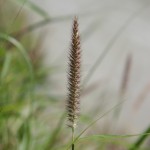Buffelgrass, Foxtail Grass
Pennisetum ciliare (L.) Link
Poaceae
Description
This tufted bunchgrass has erect or freely branching spreading stems reaching 40 inches or 100 cm arising from a knotty base. It has flat, green leaves with scattered pustule-based hairs on the topside. The leaves are thin, about 8 mm, and reach up to 30 cm long. The sheaths are at least half the internode with long, soft, and straight hairs (termed pilose) at the base. Panicles are dense, cylindrical, and up to 14 cm long by 1-2 cm wide. Two to four spikelets are grouped in bundles subtended by bristles 4-8 mm long and purplish (white when immature). In South Texas, Buffelgrass is often seeded after mechanical brush control and grows as a weed in pastures. It is considered by some to be simultaneously the most important forage grass in South Texas and an invasive and troublesome weed displacing native species. It has been identified as the most troublesome weed in Big Bend National Park. It was first introduced in San Antonio in the mid-1940s, and by the mid-1970s, it covered 90% of the seeded rangeland south of San Antonio. Buffelgrass is a perennial, warm season, introduced grass species that initiates growth in the late Spring as it lacks cold tolerance. It recovers quickly from fire and drought. It provides good grazing for livestock but poor grazing for wildlife.Habitat
Buffelgrass prefers sandy soils and disturbed sites. Native to India and Africa. Once introduced into South Texas, it has become very common in sandy soils on rangelands and disturbed areas throughout Region 6 – South Texas Plains.Images
Plant Characteristics
Duration: Perennial
Stem Texture: Hairless/Smooth
Growth Habit: Bunch grass, Grasses
Season: Warm
Distribution
 : 02 - Gulf Prairies and Marshes, 03 - Post Oak Savannah, 04 - Blackland Prairies, 06 - South Texas Plains, 07 - Edwards Plateau, 10 - Trans-Pecos
: 02 - Gulf Prairies and Marshes, 03 - Post Oak Savannah, 04 - Blackland Prairies, 06 - South Texas Plains, 07 - Edwards Plateau, 10 - Trans-Pecos
Distributions
Distribution refers to the ecological region in Texas that a plant has been found. You can also view a clickable map.
Book: Know Your Grasses (B-182)
Collection: Grasses









